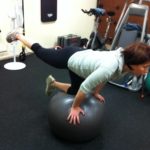Postural Awareness and Strenthening Exercises
When it comes to being human, the world is one activity in front of the body after another. This leads to the muscles being overly active in the front of our bodies while under active the the back of our bodies; Leading to something known as the slouch. I’m the first to admit that I need to watch my posture as much as the next guy so involvement of postural exercises that shift our joints back to our strongest neutral position are a must when it comes to working out. The best place to start is planks. You can modify a plank to be done on the knees or even against the wall if trying to plank on your feet is a too difficult starting point, as pictured here.
Sandy is over 70 years old and can hold a plank for over a minute. I’ve been working on her postural strength for over two years now. As you can see her positioning is ideal. You can run a line straight through the shoulder, hip and knee joint. Her shoulder blades are also retracted in, held by the postural muscles of her upper back.
Why are planks so good for posture? When a person does a plank, they are using the muscles of the core in the way they are used most of the time; without movement. Our Core muscle generally hold our posture in place as they do when walking, standing, or sitting at our computer. They are infrequently active with movement (such as abdominal crunch or low back extension type exercises). This is why isometric exercises are important. To condition a muscle, you must condition it in the way it is used because our muscles adapt very specifically to the demands we place on them. You don’t develop isometric (non-moving) strength by doing isokinetic (moving) strength exercises. Sandy has great strength but it doesn’t have to stop here. You can continue to move to more challenging exercises that develop the postural muscles further through stabilization. One foot or one hand planks are one way, or, as shown here so gracefully by my client Alisa, a plank on top of a stability ball. This can be down with one hand or one foot relying on the stabilization to come from both legs or both hands. Alisa is demonstrating the one leg form of the exercise, relying on her hands to stabilize.
The key is making it challenging enough for you and to progress when your body is ready to do so. Always feel free to contact us if you are in need of guidance to a stronger, healthier posture.



